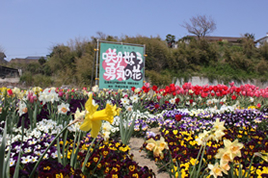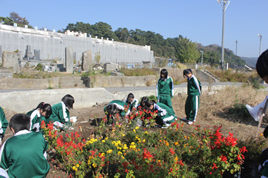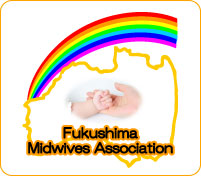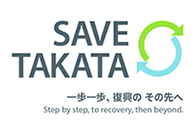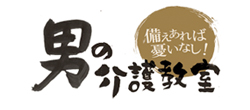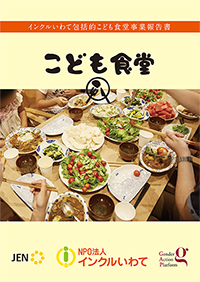
Basic Information
Iwate Prefecture
| Prefectural capital | Morioka |
| Population | 1,279,814 |
| Area | 15,275km2 |
Miyagi Prefecture
| Prefectural capital | Sendai |
| Population | 2,329,109 |
| Area | 7,285km2 |
Fukushima Prefecture
| Prefectural capital | Fukushima |
| Population | 1,896,758 |
| Area | 13,782km2 |
Tohoku recovery support Phase II (from October 2015 to March 2019)
JEN has started the emergency support and recovery support project (Phase I) based in Ishinomaki City, Miyagi Prefecture, immediately after the Great East Japan Earthquake, in partnership with local organizations. The project has entered Phase II since October 2015.
The project was implemented mainly by local people, and JEN provided business consulting, operation, and management support based on the experience learned from NGOs.
JEN has decided to give priority to supporting the businesses and program activities of people who tend to be left behind in recovery. We have partnered with organizations working for these people to help strengthen and empower the activities they promote.
JEN's partner organizations are engaged in the following activities. The activities of each partner organization will continue, but Phase II of JEN's Tohoku project has achieved some results and ended in March 2019.
Supporting pregnant women and babies (Across Fukushima Prefecture)
Midwives in Japan are appointed by the Minister of Health, Labour and Welfare.
They give advice throughout the pregnancy, assist at the delivery and after the delivery continue to offer their consultancy services to ensure the baby is well cared for and that good relationships are developed between the babies and parents and other family members.
Since the earthquake, the Fukushima Midwives Association has visited evacuation centres and run short stay programmes for mothers and babies in midwife centres.
JEN has supported the Fukushima Midwives Association since 2016
- (1) Running seminars about pregnancy – to offer advice, reassurance and information on how to access different resources i.e. maternity and medical centres.
- (2) Visiting schools to build the pupil’s self- esteem and confidence promoting the idea that every child is precious.
- (3) Baby care sessions – creating opportunities for mothers to meet midwives and also to meet other mothers so they can develop a support network and not feel so isolated.
- (4) Nutrition workshops – giving advice on cooking food for infants.
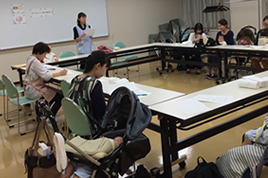
(c)Fukushima Midwives Association

(c)Fukushima Midwives Association
“SHIOKAZE Kitchen” – A system of community empowerment –
(Miyako City, Iwate Prefecture)

The partner organisation:Miyako City Council Social Welfare, Kurashi Net Miyako’s consulting room (No English available)
More than 600 people died in Miyako City as a result of the Great East Japan Earthquake. 9008 buildings were damaged or destroyed. Miyako City is one of the largest cities on the coast in Iwate Prefecture. Over the last 50 years, the population has been decreasing and getting older with younger people moving away. Social services along with the social welfare plan needs to change to fully support the remaining members of the community.
Kurashi Net, a part of Miyako City Council of Social Welfare, has been supporting the local community by running “SHIOKAZE-Kitchen” where social workers and volunteers meet local people of all ages once a month.
With the support of JEN Inclu Iwate visited and studied the “Children’s Dining Hall” in various places. It was then able to run training sessions for the staff who would manage the “Children’s Dining Hall” in Miyako city, which primarily targets single parent households.

Creating a “Live well and Work Well” town for young people
Rikuzen-takata city of Iwate prefecture suffered tremendous damage from the Great East Japan Earthquake. After the earthquake, many people were forced to leave the area due to the prolonged evacuation and lack of jobs. The city’s population has decreased by nearly 20% since the earthquake.
JEN has partnered with the SAVE TAKATA, a foundation that revolves around agriculture, IT business, and youth business in Rikuzen-takata city to support the creation of a community for the younger generation.

Women’s grassroots activities -Fostering Leadership of Young Female for the Future in Tohoku- (Iwate, Miyagi, Fukushima Prefectures)
In the 2016 version of the World Economic Forum’s Global Gender Gap Report gender inequalities are quantified around the globe, Japan was ranked 111th out of the 144 countries surveyed. Work inequalities and low representation of women in politics were especially highlighted.
In the affected areas of the Great East Japan Earthquake, there are many young women in their 20s and 30s that wish to “improve their region,” and work in NGOs or social businesses. However, because they are “young” and “female,” it is not easy for them to voice their opinions and to take part in decision-making.
Women’s Eye, an organization based on the mission that “Women can empower themselves and succeed” has implemented “Grassroots Academy Tohoku” since the Third World Conference on Disaster Reduction was held in March of 2015.
Grassroots Academy Tohoku is a place in which the next generation of female leaders from the three prefectures of Tohoku (Miyagi, Iwate, Fukushima) gather to learn from others, share their experiences, contribute and grow. JEN has partnered with Women’s Eye since 2016, to support the Grassroots Academy (2-3 times a year) in Japan both financially and by providing expertise.
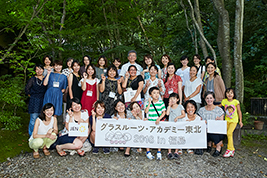
(c)Women’s Eye, photo Yumi Furusato
“Caregiving Class for Men” ~Improving the quality of life of the caregivers and the cared~ (Ishinomaki City, Miyagi Prefecture)
In the afflicted area, houses that were once lived in by three generations were lost due to the earthquake. Families had to split up and live in different temporary housing or the younger generation moved out. So now there are an increasing number of cases in which an older husband or wife has to take care of their significant other. In Ishinomaki City of Miyagi Prefecture, volunteer nurses and medical experts have noticed that at home male carers are suddenly having to do the cooking and housework and have no one to turn to for advice. Therefore, “Male Caretakers Classes” have been held since 2014. JEN has partnered with the “Male Caretakers Class” to support further enhancement of the program.
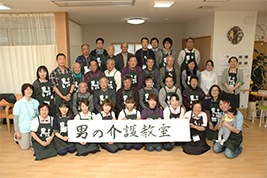
(c)COMNET Co.,Ltd.
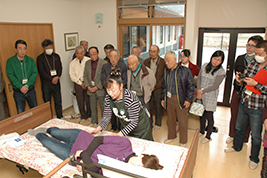
(c) Male Caretakers Classes
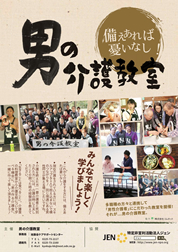
(c) Male Caretakers Classes
Creating a disaster resistant inclusive community (Iwaki City, Fukushima Prefecture)

The partner organisation:Training Center for Gender & Disaster Risk Reduction (GDRR) - No English available
A regional population includes all types of people; from small children to older citizens, people with differing disabilities, illnesses, and native languages. Involving diverse participants in disaster risk reduction, to make them well prepared for emergencies is the way to build a resilient community.
Following the Great East Japan Earthquake, the Gender Equality Center in Tohoku took the initiative to run training sessions on gender equality and disaster. Participants included staff of municipalities and fire departments, as well as local community leaders. As a result of the initiative, understanding of the importance of both genders taking equal roles in disaster risk reduction has been gradually increasing. To accelerate this and for gender-equal perspectives to take root in the region, the Training Center for Gender & Disaster Risk Reduction (GDRR), has been using its vast know how and experience to educate local organizations and individuals. JEN partners with GDRR and supports its activities.

(c)Training Center for Gender & Disaster Risk Reduction (GDRR)
Children’s Restaurant (Morioka City, Iwate Prefecture)
In December 2016, JEN’s full assistance for Inclu Iwate had finished. Now Inclu Iwate has got financial support from the local government and private sectors. Currently, they are one of the active organisations in Iwate Prefecture and work for the local people and children. As an expert of Children’s Restaurant, Inclu Iwate has started to support SHIOKAZE Kitchen in Miyako City. JEN has still carried on the partnership between Inclu Iwate and we occasionally assist them.
Activities In Ishinomaki (March 2011-October 2015)

At 2:46 p.m. on 11 March, 2011, a 9.0 magnitude earthquake, the greatest ever recorded in Japan, occurred off the coast of Miyagi Prefecture. More than 20,000 were recorded missing or dead due to the earthquake and the ensuing 23.3 meter tsunami and fires. About 20,000 houses collapsed and over 300,000 residents evacuated their homes; victims were forced to take shelter in harsh surroundings. A succession of days with below-freezing temperatures in the disaster-affected areas worsened a shortage of heating equipment in addition to a shortage of food in shelters whose numbers surpassed 1,000 in Miyagi Prefecture alone.

On the 13 of March, 2011, JEN launched an emergency operation in Sendai City, Miyagi. Since opening a branch office in Ishinomaki City, one of the worst-hit areas, we have been working on restoring the local economy, helping people regain their livelihoods in the medium and long term, while providing much-needed psycho-social care.
Our Activities During the Emergency Phase (March 2011-February 2012)

Right after the earthquake, we dispatched the first team to Miyagi to distribute emergency supplies while having a clear understanding of the situation, needs for assistance, and transport and procurement routes of supplies. The relief aid JEN distributed included clothing, personal hygiene products and fresh food for soup kitchen. With the help of evacuees themselves, a total of 600 hot meals were also provided.
1. Assistance for Remote Hardest-to-Reach Areas
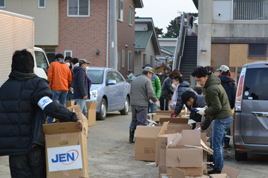
There were a number of areas and evacuation centers left isolated because of closed roads. Assistance request initiated by the local government was tough particularly in the areas where public offices had been swept away by the tsunami. Thus, we distributed emergency supplies to what is called the geographically remotest areas which included Higashimatsushima City and Ishinomaki City.

We also set up hubs in areas of Ishinomaki City where residents remained at their homes. The soup kitchen remained in service with the help of community volunteers and residents who had returned from evacuation centers to their sometimes half-collapsed homes. A total of 21,919 meals were provided for four months following the disaster. The hubs were afterwards converted into places of relief for local residents as "community space".
2. Flexible Assistance to Meet the Victims’ Changing Needs
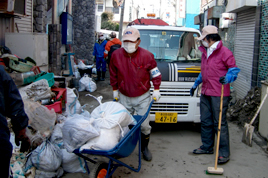
The severity and extent of the damage by the natural disaster had made complicated getting information on victims' needs in the disaster-affected areas. Our responses were to dispatch volunteers, set up soup kitchens and distribute goods including 200sets of tool kit to remove debris for mainly in the hardest-to-reach areas in order to avoid duplication of assistance. We assessed on a weekly basis what goods were required before transporting and distributing supplies to the areas.
3. Community Revitalization and Psycho-social Care
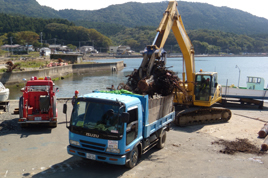
A total of 29 vehicles were leased to professional waste disposal drivers who had lost their vehicles to the disaster and had no means to get back to work. This not only enabled the removal of debris but also led to more job opportunities for the many victims who could no longer pursue their former livelihood occupations.
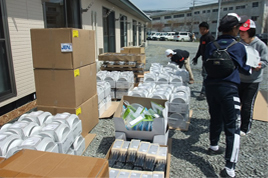
Upon the completion of the temporary housing complex in Ishinomaki City, we distributed 70 items of daily commodities to 6,890 families in temporary housing units and heaters to 6,180 families.
Livelihood Recovery Assistance
Fish Farming Industry Assistance Project (September 2011-May 2012)

We delivered livelihood recovery assistance to heavily-damaged fishing villages. In order to support the revitalization of devastated fish farming industry, we provided piscicultural equipment (**) to the Miyagi Prefecture Fisheries Cooperative, Ishinomaki District (*), and to the Minami-sanriku Fisheries Productive Association, as well as building six lodging houses for fishermen.
* Ishinomaki Area Branch, Eastern Ishinomaki Branch, Maeami Branch, Samenoura Branch, Yagawa Branch, Tomari Branch, Yoriiso Branch, Omotehama Branch, Kitakami-cho Jusanhama Branch and neighboring coastal areas.
** 300 water tanks, 10,000 sandbags (used as weight in fish-raising), 11 large-sized tents, 7 generators, 1400 fish baskets, 13 forklifts, 1 winch, gravel and ropes.
Fish Net Project (September 2011-September 2012)

We implemented the Fish Net Project as emergency assistance to help fishermen who desired the resumption of the fishing industry regain an income. JEN gathered from across Japan the materials to produce the nets and then distributed them to the local residents. The produced fish nets were then purchased by JEN. As much as four million square meters of fish nets were made and the nets were distributed by the fisheries cooperatives to fishermen. The initiative brought about encouragement to the people living off the fishing industry. Furthermore it created an opportunity for some experienced fishermen who had knowledge in fish net making to pass on their skills to the younger generation.
Temporary Shopping Arcade “Oshika Noren Avenue” Project (November 2011-May 2012)

To help victims who had lost the way to make a living rebuild their lives in Oshika-Ayukawa, we set up a temporary shopping arcade, the "Oshika Noren Avenue", with the help of Oshikainai Commerce and Industry Association in Ishinomaki City in November 2011. Local residents who have joined the arcade have been working on PR activities and sales promotion, giving them a feeling of being at the center of the restoration of the Oshika Peninsula.
Miyagi Prefecture Fisheries Cooperative’s Women's Section Assistance Project (March 2012-July 2013)

Although the Miyagi Prefecture Fisheries Cooperative’s Women's Section used to have a key role as keeper of the coastal areas' life and culture –it took care for instance of the marine-accident orphans and provided dietary education- the disaster scaled down their activities. As means to resume and finance the program once again, we supported the making and selling of accessory made with young abalone shells, “Watatsumi (the god of the sea)”. Since the sales went well, JEN discontinued the assistance and the Fisheries Cooperative has carried on the project on their own since July 2013.
Exchange Program
Volunteer Program (April 2011-December 2013)
JEN's volunteer dispatch program started with debris removal during the emergency phase, and then evolved into an exchange program which included fisheries assistance, farm land revitalization and tree planting. We have accepted a total of more than 10,000 volunteers (as of February 2014), and we still are recruiting volunteers periodically to meet the victims’ changing needs
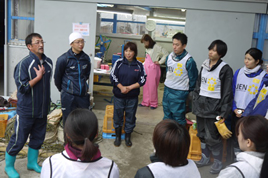

Community Revitalization Assistance
“Community Space” Project (since May 2011-2014)


We renovated the meeting houses and/or built alternative facilities in three areas where the meeting houses had been damaged by the tsunami. These facilities were operated by local residents as “community spaces” where they could comfortably and casually drop in to socialize. In the Koganehama district, in Watanoha, we repaired and renovated the damaged meeting house, and then we set up a new administration committee with some residents. In the Kamikama area, in Ishinomaki City, we provided soup kitchens to residents from March 2011. We then refurbished the building of a local company to open a place where people can get together in July of 2011. As its role came to an end, the community space closed in the summer 2013. However, in the winter of 2013, local residents launched a project of building a new meeting house which is now being built.
Temporary Housing Complex Assistance Project (July 2011-September 2013)

We delivered psycho-social care in the meeting house located in the temporary housing complex of Ishinomaki City comprising of 6,890 families. We also supported the formation of local residents’ neighborhood association, and we participated in the elaboration of fire drill exercises and evacuation map-making.
Community Radio Program "Sukidaccha ♥ Ishinomaki" Project
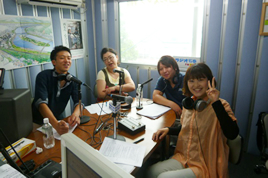
We produced a community radio program with the hope that it would give courage and hope to victims. For a total of 17 weekly episodes, 21 local residents who were active in restoration in their respective community were invited to share their approaches, their worries and their process towards restoration. The program allowed local residents in Ishinomaki City to share their feelings and wishes through the radio and helped boost their motivation for recreating their communities. The program was shared via the Internet across the globe, which brought an opportunity for a global audience to find out about the restoration progress of Ishinomaki City and understand the local community's feelings.
Sasunohama Region Support Project(2012-March 2013)

In 2012, JEN set up a multi-purpose communal facility called Hama Yuu at the entrance of Sasu Beach as the focal point of regional regeneration. At first, the plan was to create a space where displaced residents can come together and interact. In December of 2012, the space started off as a locally-operated oyster restaurant. In March 2013, the menu was expanded, and interaction between residents and visitors increased. In 2013, roughly 4,000 people visited the restaurant facility from outside the city, in effect contributing to the regeneration and development of the region.The restaurant is now independently administered and operated by local residents.
Exchange Project “Let’s go to the Sea!”(2012-2014)

At year-end 2012, JEN facilitated a discussion with the residents living along the Eastern shore about how they wanted to regenerate their neighborhood. The two keywords that repeatedly came up in the discussions were 1) “regeneration of the fishing industry” and 2) “more opportunities for personal interactions”. As a way to address this second concern, JEN kicked off the “Let’s Go to the Sea! Fishing Industry Experience” in a joint effort with the local residents. Then in 2014, the “Let’s Go to the Sea!” project really gained momentum, spreading across the Oshika Peninsula, transcending its former limitations of just being about the sea and growing to be a core cooperative program in the area.
We hope that this project will continue to be a way to allow visitors to enjoy the region’s seasons, nature, and traditions and galvanize them to become partners in our effort to regenerate the region. JEN will continue to work with this project by recruiting participants, being involved in the operation, and facilitating project proposal meetings and workshops.
Promoting Self-Sufficiency in Temporary Housing
From the initial emergency period of the disaster, JEN has been providing a wide variety of community support, including workshops for the establishment of a temporary housing council and the reestablishment and operational support of a community communication space in the three coastal regions in which we are active.
As emotional support is just as important as providing temporary housing or food, JEN has been incorporating activities that build and enrich the day-to-day lives of those living in the temporary housing units from May 2011. These include fun activities such as “Tea Time”, flowerbed making, and handicrafts. Others include relaxation exercises taught by on-site clinical psychotherapists and disaster preparedness training taught by the local firefighters. Three years since the disaster in 2014, many of those residing in these temporary housing units are becoming increasingly concerned with their living situations. JEN has been planning various activities to address their fears and concerns as well as motivating and helping them achieve self-sufficiency once again. JEN will continue to support those affected by the disaster as they transition from living in temporary housing units to the new public housing units.
Ishinomaki Handicraft Experience Project(2013-2014)
JEN has been promoting the empowerment of women through handicrafts. At the community hall in the temporary housing complex, JEN kicked off its first Ishinomaki Handicraft Experience in the spring of 2013 with more than 40 groups participating. By holding and assisting in the operation of these Handicraft Experiences periodically, JEN hopes to promote networking and skill-building amongst women.


Nurturing Future Reconstruction Leaders in Ishinomaki
From the emergency period of the disaster, JEN created spaces for kids and provided academic and emotional support. Motivated by a desire to provide activities to relieve stress and get the young residents moving again, JEN offered dance lessons, held soccer tournaments, and offered other programs that encourage goal-setting among the children. Other programs focused on the healthy development of kids living in the affected regions as well as workshops and activities to help develop leadership among the community’s youth. With the help of other regional volunteers, JEN was able to renovate some of the public schools, repair and set up playgrounds and toys, and facilitate programs that taught kids about the Ishinomaki region and its beauty.


Schoolyard Equipment Assistance Project (December 2013–February 2015)
In 16 elementary schools in the areas flooded by the tsunami in Ishinomaki City, the schoolyard equipment has become unusable or partially unusable due to salt damage. Giving consideration to the repair and donation plans, JEN donated new equipment and repaired the existing ones in four schools. Through this project, we were able to develop an environment where children can play safely in all schools in the flooded areas. JEN also maintained small parks in the residential areas that had been left unrestored.
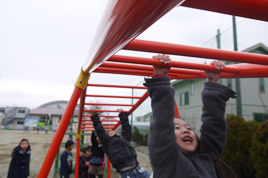

Kodomo-kai (Children’s Club) Revitalization Project (March 2014–February 2015)
The earthquake disaster significantly reduced the opportunities for children to do outdoor exercise and the places where they can play safely. JEN redeveloped safe places for children to resume kodomo-kai activities as a watch-over system in areas where the activities have been suspended since the earthquake occurred. We promoted cooperation and strengthened the community while the residents themselves discussed the design of the parks and the rules of use. In addition, through participating in park maintenance efforts the residents’ awareness has been nurtured in such a way that the parks really belong to them. The resumption of kodomo-kai was originally scheduled for fiscal year 2015, however, triggered by this project, kodomo-kai activities have restarted ahead of schedule in February 2014, and their meetings and events have been organized since then.

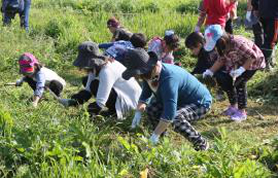
Parent-Child Home College (March 2014–February 2015)
After the earthquake, parents themselves have been suffering from stress arising from the difficulty of living due to the delay of reconstruction and the anxiety about the future, and many parents tended to lose heart in taking care of their children. As an opportunity to improve the situation where parent-child conversations have become less frequent and the depth of contact between them has become weaker, JEN held a series of events to learn about Ishinomaki, their hometown. Through this six-series event, parents and children refreshed their minds and bodies by being freed from their daily lives. Our aim was to promote psychosocial care of both parents and children to improve the family environment. In the presentation session at the end, they shared that their communication at home has improved by talking about these events as well as about other topics. In addition, many parents commented on their children’s growth and the psychosocial care. “We had been avoiding sea bathing since the quake, but we very much enjoyed [sea bathing], so we were reassured that we are safe now,” one parent said.
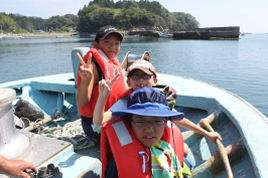
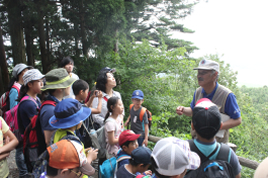
The “Reconstruction Plan We Can Carry Out” Project (November 2012–March 2014)
Since Fall 2012, JEN has assisted the “Reconstruction Plan We Can Carry Out” project initiated by the students of Kadonowaki Junior High School under the slogan: “Let's fill the town with flowers to regain colors from being gray.” By supporting the voluntary activity of the children with local residents and volunteers, the beautiful flower beds created in the affected area have given courage to many people. Children will play an important role in the reconstruction efforts of the future. JEN encouraged them to act proactively so that they will be able to develop a positive attitude that they can contribute to something if they try.
